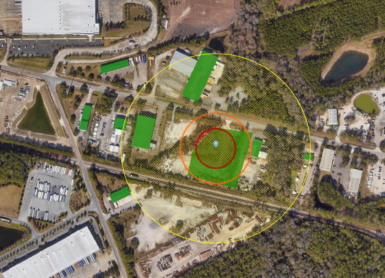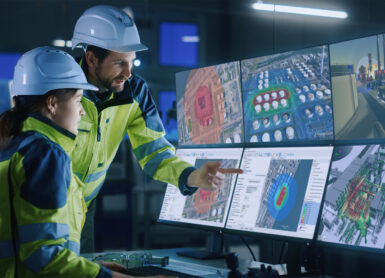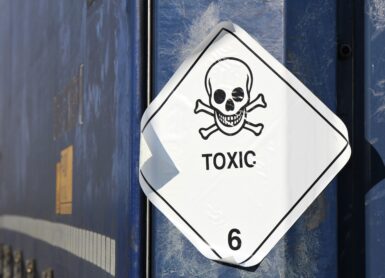
In a previous post, we elaborated on different fire phenomena, which might occur depending on the chemical’s phase and time of ignition. The pool fire phenomenon is often very relevant for commonly used liquid, flammable materials such as gasoline and hexane. But even for a pool fire event, we can still distinguish between several different appearances.
The pool fire phenomenon explained
Any flammable liquid release can create a spreading pool on the ground or even on a water surface. On the other hand, the pool can spread without restraint or be delimited by the shape of a bund or a dike, limiting the maximum surface area of the pool. If the tank has lost its roof, an exposed surface of a flammable liquid will potentially ignite (i.e., tank top fire). In all these cases, the ignition will start a pool fire (see Figure 1 below for some examples of pool fires).

We can describe the pool fire phenomenon as the combustion of a material evaporating from a liquid layer at the fire’s base. It consists of a turbulent diffusion fire burning above a horizontal pool. This liquid vaporises flammable material under conditions where the flammable vapour has zero or very low initial momentum.
The pool with flammable material is not necessarily static in its dimensions. It may be spreading or contracting. Additional combustible material could be fed into the pool from a leak. The liquid receives heat from the flames by convection and radiation and may lose or gain heat by conduction toward/from the solid or liquid substrate under the liquid layer. On the other hand, if the fuel is cryogenic, heat is transferred from the substrate to the fuel, and combustion will be enhanced [1].
Heat radiation from a pool fire causes a heat flux with the potential to cause damage to objects in the surrounding area. That is why it is highly relevant to assess the consequences of such a scenario to help safety professionals devise prevention and mitigation measures so that accidental releases can either be prevented or their consequences minimized.
This blog post will explain how easy it is to simulate pool fires in EFFECTS, more specifically, how to simulate a tank pit fire and a tank top fire. These two scenarios are prevalent in the chemical industry and feared because of their potential impact on neighbour tanks (creating domino events). A tank pit fire occurs when a bund of specific dimensions contains the liquid spill that ignites. The rooftop fire occurs when a tank has lost its roof due to an explosion or a floating roof malfunctioning, resulting in an exposed top layer of liquid that ignites.
The pool fire model in EFFECTS
Types of pool fires
The Pool Fire model available in Gexcon’s consequence modelling software EFFECTS can simulate the release of an instantaneous or a (semi-)continuous pool. The release is instantaneous when, for example, the tank collapses, and it is (semi-)continuous when there is leakage through a hole in the tank or a hole in a short pipe connected to the tank.
On the other hand, the Pool Fire model in EFFECTS can simulate any pool fire scenario because it allows you to define its dimensions, pool height, and even pool shape: it does not always have to be a circular pool. You can specify the pool shape to be circular, rectangular, or polygonal. There is even an option in EFFECTS that allows you to simulate a rimfire (a ring of fire around a floating roof with a leaking seal).
Simulating a polygonal shaped pool is particularly useful to account for the tank pit fire scenario, allowing you to draw the shape of the bund (dyke) that contains the spill of flammable liquid. For a free spreading pool, you would typically select a circular-shaped pool. In this case, the final pool diameter will depend on the release type and combustion rate. In addition, simulating a circular pool fire can also account for the tank top fire scenario, where the pool’s height equals the height of the tank.
Two different mathematical approaches
The EFFECTS Pool Fire model offers two different mathematical approaches, which you can choose from: the Yellow Book model [2] and the Two Zone (Rew & Hulbert) model [3].
The Yellow Book model is a more straightforward model based on the theory of the Yellow Book. In contrast, the Two Zone model is a more realistic model based on empirically derived (substance-dependent) burning properties. This Two Zone model distinguishes the clear flame (at the bottom of the pool fire) from the sooty flame (at the top of the pool fire).
The distinction between the top and bottom flame is that the soot production of the burning material highly influences heat radiation. While the bottom part of the flame may be clearly visible and brightly radiating, the top part of the flame may be obscured by smoke. This phenomenon, known as smoke blockage, strongly affects the overall thermal radiation emitted from the fire. This soot effect is dependent on the pool size and the type of fuel being burned.
Therefore, the EFFECTS Two Zone pool fire model will report a different Surface Emissive Power for the top of the pool fire (sooted flame) compared to the bottom (clear flame). Using empirically derived (material and pool diameter dependent) burning properties eliminates sensitivity for user estimations of soot behaviour.
How to use pool fire model in EFFECTS to calculate tank fire
To explain how to use the pool fire model in EFFECTS, let’s look at two examples: a tank pit fire and a tank top fire.
Tank pit fire
Let’s assume that we have a storage vessel to simulate a tank pit fire, as depicted in Figure 2 below. The vessel suffers from a catastrophic rupture releasing all its contents into a bund. The flammable liquid contained in the bund ignites, generating a tank pit fire.

Simulating this scenario in EFFECTS is very straightforward. You can do so as follows:
- First, add a pool fire model in EFFECTS.
- Introduce all the main input parameters of the pool fire model, such as the amount of mass involved in the release, storage temperature, ambient temperature, wind speed, and relative humidity.
- Because the vessel is enclosed in a bunded area, you can choose the shape of the pool to be polygonal. Thus, the pool fire will occur within that bunded area (which we call a tank pit fire).
- Draw the shape of the pool on the map (see Figure 3 below). Using a tile server background image lets you follow the tank pit contours visible on the satellite image.

- Assuming that the other tanks in the bund remain intact, the area where those tanks are placed will not burn. That is the reason why you can indicate in the model what is the corresponding non-burning area. This non-burning area will correspond to the footprint of the non-failing tanks, which will result in a more realistic flame dimension. You can directly measure the area or diameter of the non-failing tanks in EFFECTS. For that, you can use the ruler functionality in the EFFECTS user interface. This ruler will allow you to measure the diameter of the tanks (and then calculate their area with A=π.r2) or measure the area of the top of the tanks directly. These measurements will already be up to scale when using a tile server or a georeferenced image.
- Calculate the model.
- As you can see from Figure 4, you can quickly obtain the heat radiation and lethality contours of a tank pit fire in just a few quick steps. The pool fire model (or any fire model in EFFECTS) also allows you to report a top view or side view heat radiation grid. Thus, you can read out values from the grid, which is a straightforward and quick way of determining the heat radiation value at a selected coordinate in the map.
- You can also export your contours to Google Earth by simply doing a right-click on the legend of the contours you wish to export, select “Export to file”, and save the exported file as a KML file. Double click on the generated KML file to open the contours (or grid) in Google Earth (see the result in Figure 5)


Tank top fire
To simulate a tank top fire, let’s assume that we have the same storage vessel as the previous example. Nevertheless, in this scenario, the tank has lost its roof, and the exposed top surface with the flammable liquid ignites, generating a tank top fire (see Figure 6 below).
We can model this scenario as an elevated circular fire.

Simulating this scenario in EFFECTS is as straightforward as the previous case. The modelling approach is pretty much the same as in the previous example, with only a couple of differences:
- You need to set the shape of the pool to be circular, where the maximum pool surface area corresponds to the surface of the top of the tank. Using the ruler in the EFFECTS user interface, you can easily calculate the actual surface of the top of the tank, as explained in the previous example.
- You need to indicate that the height of the pool is equal to the height of the tank (as the pool fire occurs at the tank’s top).
The EFFECTS Pool Fire model also reports the side view contours of the fire, as shown in Figure 7. As the figure illustrates, the fire starts at a certain height, which corresponds to the height of the tank.

As you can see from these examples above, simulating tank pit fires and tank top fires in EFFECTS is uncomplicated, undemanding, and unchallenging.
Would you like to see examples of tank pit fire and tank top fire simulations in EFFECTS?
Download the project file below, which contains a simulation for the tank pit fire and tank top fire scenarios explained in this post.
You can open the project file with the free EFFECTS viewer, available for download via the button below.
[1] Joaquim Casal. Evaluation of the Effects and Consequences of Major Accidents in Industrials Plants. Second Edition 2018. Elsevier. ISBN: 978-0-444-63883-0.
[2] Yellow Book. Methods for the calculation of physical effects due to releases of hazardous materials (liquids and gases). CPR 14E. Committee for the Prevention of Disasters. Third edition, second revised print 2005.
[3] Rew, P.J. & Hulbert, W.G., Development of a pool fire thermal radiation model’, HSE Contract research report no. 96., 1996
Do you like what you read?
Get the latest trends in the field of process safety management straight to your inbox, and enhance your skills through knowledge sharing from industry experts.


